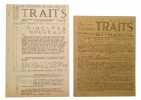1803 books for « moore p »Edit
-
Type
Book (1780)
Drawings (1)
Magazine (1)
Music sheets (18)
New book (1)
Photographs (1)
Postcards (1)
-
Latest
Last 24h (1)
Last month (117)
Last week (4)
-
Language
Dutch (2)
English (22)
French (1777)
Russian (2)
-
Century
16th (2)
18th (12)
19th (63)
20th (817)
21st (303)
-
Countries
Belgium (79)
Brazil (1)
Canada (20)
China (1)
Denmark (10)
France (1508)
Germany (1)
Greece (2)
Italy (6)
Netherlands (7)
Switzerland (163)
United Kingdom (3)
United States of America (2)
-
Syndicate
ALAC (16)
CLAM (5)
CLAQ (6)
CNE (1)
ILAB (775)
NVVA (9)
SLACES (9)
SLAM (713)
SNCAO (2)
Topics
- Adam (244)
- Africa (3)
- American literature (4)
- Anticipation (8)
- Archaeology (5)
- Architecture (16)
- Army (5)
- Asia - orient (4)
- Astronomy (17)
- Bengal, (9)
- Berlitz (5)
- Biography (4)
- Bradley (9)
- Cap (4)
- Children’s books (25)
- Cinema (9)
- Comedy (4)
- Comic strip (84)
- Cryptogamy (4)
- Dali (4)
- Decoration (5)
- Detective novels (149)
- Drawings (14)
- Early printed books (3)
- England (6)
- English (62)
- English literature (6)
- Entomology (11)
- Erotic (4)
- Fantastic (13)
- Fantasy (6)
- Fashion (4)
- Feminism (4)
- Fine arts (19)
- First edition (21)
- Flora (11)
- Games toys (4)
- Geography (4)
- Guide books (3)
- History (40)
- Hunting (5)
- Ireland (5)
- Law (4)
- Literature (303)
- London (5)
- Mathematics (4)
- Miller (5)
- Miro (4)
- Monographs (15)
- Moore audrey (4)
- Moore george (25)
- Moore henry (9)
- Moore patrick (15)
- Moore thomas (22)
- Moore william (4)
- Museums (3)
- Music (6)
- Navy (16)
- Odysseus (4)
- Palaeontology (12)
- Palaeozoology (3)
- Periodicals (9)
- Philosophy (15)
- Photography (5)
- Poetry (11)
- Police (22)
- Policy (8)
- Popular literature (4)
- Posters (3)
- Prehistory (7)
- Psychology (6)
- Quebec (4)
- Religions (8)
- Review (5)
- Robin (38)
- Ruth (25)
- Salvador (4)
- Science fiction (26)
- Sciences (15)
- Sciences & technique (4)
- Scores (23)
- Script-writer (12)
- Sculpture (24)
- Sexuality (4)
- Short stories (4)
- Sociology (6)
- Songs (18)
- Sports (3)
- Spying (74)
- Tea (5)
- Translation (4)
- Travel (6)
- United kingdom (5)
- United states (8)
- Various (8)
- Viviane (85)
- War (12)
- Williams tennessee (12)
SPAWN / WildC.A.T.S
Delcourt, DL juillet 2010, achevé d'imprimer en juin 2010. Un album cartonné d'environ 26 x 17 cm, 108 pages, très bon état.
Merci de nous contacter à l'avance si vous souhaitez consulter une référence au sein de notre librairie.
Suprême, tome 2, le Retour.
Editions Delcourt, DL Juillet 2009, achevé d'imprimer Juin 2009, première édition. Un album cartonné d'environ 18 x 27 cm, 268 pages plus 12 pages d'hommages et de recherches graphiques. Très bon état dans l'ensemble, malgré de très légères traces d'humidité sur les gardes.
Merci de nous contacter à l'avance si vous souhaitez consulter une référence au sein de notre librairie.
Promethea, tome 4.
Panini Comics, DL Mars 2007. Un album broché d'environ 17 x 26 cm, non paginé. Très bon état.
Merci de nous contacter à l'avance si vous souhaitez consulter une référence au sein de notre librairie.
Promethea, tome 5.
Panini Comics, DL Mars 2008. Un album broché d'environ 17 x 26 cm, non paginé. Très bon état.
Merci de nous contacter à l'avance si vous souhaitez consulter une référence au sein de notre librairie.
Promethea, tome 7.
Panini Comics, DL Février 2010. Un album broché d'environ 17 x 26 cm, non paginé. Très bon état.
Merci de nous contacter à l'avance si vous souhaitez consulter une référence au sein de notre librairie.
L'architecture sensible : espace, échelle et forme.
Dunod 1981 Dunod, 1981, 187 p., broché, coins des plats cornés, une déchirure sans manque d'environ 2cm en bordure du second plat, intérieur bien propre toutefois.
Merci de nous contacter à l'avance si vous souhaitez consulter une référence au sein de notre librairie.
Principia Ethica. - [FOUNDING ANALYTIC PHILOSOPHY - INTRODUCING THE NATURALISTIC FALLACY]
Cambridge, 1903. 8vo. Orig. brown full cloth with gilt lettering to spine. Gilt armorial centre-piece to front board (indicating that this was a prize from ""Coll. di Joh. Bapt.""). A bit of bumping to capitals and corners, otherwise fine. Inner hinges slightly weak and a few marginal pencil annotations. XXVII, (1), 232 pp.
First edition of Moore's seminal magnum opus, his hugely influential ""Principia Ethica"", which helped found analytic philosophy and introduced and named the ""naturalistic fallacy"". ""Moore's ""Principia Ethica"" (1903) is a landmark in the history of ethics. Its impact and influence on subsequent ethical theory, at least in Anglo-American philosophy, have been tremendous. Its specific doctrines of the indefinability of good and of the naturalistic fallacy, whether reinforced, amended, or even rejected, by later theorists, have served as the starting points of much of twentieth century philosophy."" (Morris Weitz, 20th-Century Philosophy: The Analytic Tradition, (1966), p. 68).George Edward Moore (1873-1958) is one of the most influential twentieth century philosophers, and his contributions to analytic philosophy can be compared only to those of Russell, Wittgenstein, and Frege, with whom he founded this philosophical discipline. His impact on Anglo-American philosophy in the 20th century is unsurpassed. ""Principia Ethica"" is the most important of Moore's works. In this work, he makes use of analysis to establish the main doctrines of the book, and thereby lays one of the cornerstones of analytic philosophy. Moore here applies logic to ethics and shows us how this can provide a better foundation for ethics. Moore begins by showing that analysis will reveal to us that ""good"" is a simple, non-natural, and indefinable property, which cannot itself be defined and analyzed, because it is not a complex object that can be divided, but a simple object of thought and goes on to define ethics as an inquiry into what is good. He furthermore shows how sometimes false premises in the definition of good lead to false conclusions about ethical behavior and he introduces his seminal concept ""naturalistic fallacy"", which is defined as the error of assuming that ""good"" can be defined by naming various properties of things which we believe to be good. ""Naturalism"", according to Moore falsely assumes to have defined ""good"" and is therefore unable to provide any logical reason for any principle of ethics.""It appears to me that in Ethics, as in all other philosophical studies, the difficulties and disagreements, of which history is full, are mainly due to a very simple cause: namely to the attempt to answer questions, without first discovering precisely WHAT question it is which you desire to answer. "" (Moore, Preface, p. VIII). ""The influence [of ""Principia Ethics""] was not only overwhelming"" it was exciting, exhilarating, the beginning of a renaissance, the opening of a new heaven on a new earth, we were the forerunners of a new dispensation, we were not afraid of anything."" (Keynes).
Illustrations of The Loves of The Angels a poem by Thomas Moore. Engraved by Charles Heath from drawings by R. Westall.
London, Longman Hurst, Rees, Orme, and Brown,1823. 24,5 x 16,5 cm, iv-134 pp. Relié demi-maroquin bleu nuit, dos à nerfs, caissons ornés, titre doré. Reliure signée Champs-Stroobants Sr. Quelques épidermures et traces de frottements sinon bel exemplaire.Édition illustrée rarissime, la notre comporte un portrait de Moore en frontispice, un titre gravé et 8 gravures dont deux en double état (avec texte et sans texte). Soit 11 gravures y compris le frontispice. Le tout imprimé sur beau papier.
Thomas Moore (né à Dublin le 28 mai 1779 - mort à Sloperton Cottage (Bromham, Wiltshire, Angleterre) le 25 février 1852) est un poète irlandais. Il voyage en Europe, notamment à Venise où Byron lui confie son journal. Entre 1820 et 1822, il est accueilli à Sèvres près de Paris par la famille de Martin de Villamil. Il est particulièrement connu pour ses "Irish Melodies" contenant 130 poèmes tels que The Minstrel Boy ou La dernière rose de l'été qui, mis en musique par Moore lui-même et Sir John Andrew Stevenson, sont emblématiques de l'Irlande, très appréciés et très souvent repris. Ils ont fait de Moore un héros populaire pour les nationalistes irlandais Son uvre a beaucoup marqué le compositeur Hector Berlioz qui lui emprunte le terme « mélologue ». Le peintre Gilbert Stuart Newton a réalisé un portrait de lui. En 1849, il tombe dans la démence sénile et meurt à Sloperton [archive] (Bromham, Wiltshire, Angleterre) le 25 février 1852.
Proof of an External World. Annual Philosophical Lecture Henriette Hertz Trust British Academy. - [""MOORE'S MOST FAMOUS PAPER""]
London, Humphrey Milford, 1939. 8vo. Offprint in the original printed wrappers. Uncut. Ex-libris [Danish philosopher Carl Henrik Koch] pasted on to verso of front wrapper. Wrappers with various nicks and bumped corners and some miscolouring to boarders. Internally with a few occasional very light pencil markings in margin. 30. (1) pp.
First edition of Moore's important paper on the existence of an external world. In ""Moore's most famous paper, his 'Proof of an External World' [...] [he] sets himself the task of doing what Kant had earlier set himself to do, namely providing a proof of the existence of 'external objects'. Much of the lecture is devoted to working out what counts as an 'external object', and Moore claims that these are things whose existence is not dependent upon our experience. So, he argues, if he can prove the existence of any such things, then he will have proved the existence of an 'External World'. Moore then maintains that he can do this""(SEP): ""By holding up my two hand, 'Here is one hand' and adding, as I make a certain gesture with the left, 'and here is another'.(p. 25). [...] But did I prove just now that two human hands were then in existence? I do want to insist that I did" that the proof which I gave was a perfectly rigorous one" and that it is perhaps impossible to give a better or more rigorous proof of anything whatever"".
( Photographies - Cinéma - James Bond 007 ) - Sir Roger Moore.
Reference : 28934
(1980)
Photographie en tirage argentique en noir et blanc de Sir Roger Moore pour la diffusion télévisée du film " The Naked Face " sur TF1 en 1990.
Photographie en tirage argentique en noir et blanc de Sir Roger Moore pour la diffusion télévisée du film " The Naked Face " diffusée sur TF1 en 1990. Format 17,5 x 12,5 cm. Cachet de l'agence Kipa et notes de la chaîne, collées au verso. Etat superbe. Sir Roger Moore est un acteur britannique, né le 14 octobre 1927. Il fut à l'écran : Ivanhoé, Simon Templar alias le Saint, Lord Brett Sinclair dans amicalement vôtre, avant d'interprèter James Bond - succédant à Sean Connery et George Lazenby - dans sept opus de la série de films entre 1973 et 1985. En hommage à sa carrière cinématographique, il fut anobli par la reine Élisabeth II le 14 juin 2003.La Machination ( The Naked Face ) est un film américain réalisé et scénarisé par Bryan Forbes, sorti en 1984. On trouve dans les rôles principaux : Roger Moore, Rod Steiger, Elliott Gould, Anne Archer.
Vente exclusivement par correspondance. Le libraire ne reçoit, exceptionnellement que sur rendez-vous. Il est préférable de téléphoner avant tout déplacement.Forfait de port pour un livre 8,50 €, sauf si épaisseur supérieure à 3 cm ou valeur supérieure ou égale à 100 €, dans ce cas expédition obligatoire au tarif Colissimo en vigueur. A partir de 2 livres envoi en colissimo obligatoire. Port à la charge de l'acheteur pour le reste du monde.Les Chèques ne sont plus acceptés.Pour destinations extra-planétaire s'adresser à la NASA.Membre du Syndicat Lusitanien Amateurs Morues

BACKWÖRKS
1978 -Catalogues n°C, 1978, 430x290mm, 8p. en feuilles: Our line of very expensive Merchandise.Oeuvres de Robert Filliou, Daniel Spoerri, AY-O, George Brecht, John Cage, Red Grooms, Scott Hyde, Ray Johnson, Al Hansen, Joe Jones, Allan Kaprow, Alison Knowles, Yoko Ono, Ben Patterson, Takako Saito. Illustré de photographies de Joanne Stamerra et Peter Moore.-Catalogue L115, 10/79, 355x216mm, 8p., agrafé: The Something Else Press.Description de 81 numéros de livres et documents de cette illustre maison d’édition fondée et dirigée par Dick Higgins.-Une carte de visite du 488 Greenwich st avec une photographie de Dick Higgins, format 79x49 mm.-Une feuille promotionnelle 275x213mm : “Backworks documents and relics of experimental art 488 Greewich st. NY 10013 Jon Hendicks Barbara Moore”, sur fond photographique montrant Jon Hendricks et Barbara Moore assis au bord des fenêtres de leur galerie. (103738)
Fondée et dirigée par Barbara Moore et Jon Hendricks la Librairie Backworks (1976-1981) proposait au 488 Greenwich Street à New York, des oeuvres d’artistes d’avant garde la plupart appartenant au mouvement Fluxus. Les 4 documents.(103738)
Phone number : +33 1 48 01 02 37
The Gamester. A tragedy: Written by Mr. Moore. As it is performed at the Theatre-Royal in Drury-Lane.
London, printed and sold by H. Whitworth, at no. 3, Play-house-yard, Black-Friars, (1784), Blank wrappers, 58 + (2) pp. Last page torn and stained.
Edward Moore (1712-1757), English dramatist. It is upon The Gamester that Moore's literary reputation rests the play was much-produced in England and the United States in the century after Moore's death.
The Loves of The Angels a poem.4th ed.,The fourth édition [with notes].ILLUSTRED : Illustrations of MOORE, Thomas The Loves of The Angels. London: Longman 1823
1823 London: Longman Hurst, Rees, Orme, and Brown,1823.reliure plein maroquin vert, dos decoré de caissons dorés à lyre,plats ornés d'une frise dorée,tranches dorées. x, 148 pages 21 cm,édition illustrée rarissime : titre illustré et 3 gravures ht. Full calf, 8.5 inches tall. A stunning Georgian binding with wide gilt raised bands, label, fine gilt tooling to the panels and dentelles. The remarkable boards have a central panel framed by plain calf and gilt and blind rolls on an inked calf background. A ink owners inscription on the first blank.De la bibliothéque de Mme SAINTE BEUVE, carte manuscrite jointe.BON ETAT.
Contemp. full calf with blind- and gilt-stamped decorations. First edition. - Very good copy in a beautiful binding.This is an unusual edition, written whilst Moore was living in Paris, and based on the same theme as Lamartine's 'Chute d'un ange' - published the same year as the English edition. English text. Remise de 20% pour toutes commandes supérieures à 200 €
MOORE Thomas; BYRON [George Gordon ], Lord; BROWN Thomas the younger:
Reference : 9850
The loves of the angels, a poem [relié avec] The Island; or, Christian and his comrades [relié avec] The age of bronze; or, Carem seculare et annus haud mirabilis [relié avec] Rhymes on the road, fables, etc. [relié avec] The vision of judgment. By Quevedo Redivivus. Suggested by the composition so entitled by the author of "Wat Tyler".
Paris, Galignani, 1823 / 1822. In-12 de [2]-119; [2]-95; [2]-38-[2]; XII-135; [2]-56 pages, demi-veau blond à petits coins, dos lisse orné de filets, roulettes et titre ("Byron - Poêmes") dorés, étiquette de titre caramel. Petites galeries de vers, rares rousseurs. Ex-libris Charles de Constant-Rebecque.
Un verset du sixième chapitre de la Genèse inspira l’idée de "The loves of the angels" à Moore, en même temps qu’il donna à Byron le motif d’un poème. Le mystère de lord Byron ("Heaven and Earth, a mystery") parut peu de temps avant que Moore ne publie son poème. Deux poètes amis écrivant sur le même sujet, voici ce qui explique la présence du poème de Moore dans une reliure dédiée à Byron, de même que la présence ici de "Rhymes on the road" s'explique par la dédicace à Byron. L'Age de bronze, est la satire du congrès de Vérone (1822), quant à "The vision of judgment" c'est une réponse satirique (écrite sous le nom de Quevedo "recyclé", poète espagnol du XVIIe siècle, connu pour ses satires tranchants) à la Vision du Jugement de Robert Southey publié en 1820 à la mémoire de George III. 3 texte de Byron, 2 de Moore.
Henry Moore. Exposition organisée par le British council et le Musée National d'Art Moderne.
Paris, Musée d'Art Moderne, 1949 ( Imprimé à Londres) ; plaquette grand in-8°,brochée, couverture illustrée en couleurs aux 2 plats d'une composition de Moore ; (36)pp.; frontispice ( portrait de Henry Moore) et 23 reproductions photographiques de ses oeuvres, dont 2 en couleurs.
Ce catalogue renferme 108 références ( sculptures et projets dessinés). Introduction par Herbert Read.On a joint deux coupures de presse de mars et avril 1961, sur Henry Moore au Musée Rodin. (CO2)
( Journal Tintin - Bandes Dessinées - Ian Fleming - James Bond ) - Roger Moore - Dupa - Martial - Gordon Bess - André-Paul Duchâteau - Tibet - Turk - De Groot - Michel Greg - Will Eisner -
Reference : 31958
Journal Tintin, l'hebdoptimiste, nouvelle série n° 49 spécial : James Bond 007, " Vivre et laisser mourir " avec Roger Moore et poster de l'affiche du film.
Journal Tintin, nouvelle série n° 49 de 1973. In-8 agrafé de 66 pages au format 29 x 21 cm. Couverture avec photographie de Roger Moore dans le rôle de James Bond. Plats avec petits frottis aux coins. Intérieur frais. Contient 5 pages avec photographies consacrées au film de Guy Hamilton, sorti en 1973, James Bond 007 " Vivre & laisser mourir " avec dans les rôles principaux : Roger Moore, Yaphet Kotto, Jane Seymour. A noter la chanson du générique " Live and Let Die ", paroles de Linda McCartney sur musique de Paul McCartney, interprétée par Paul McCartney et les Wings. Complet du poster central ( détaché ) reprenant l'affiche du film. On trouve aussi des BD de Dupa, Martial, Gordon Bess, André-Paul Duchâteau et Tibet ( Enigme avec solution de Ric Hochet ), Turk, De Groot, Michel Greg, Will Eisner ( aventure complète du Spirit en couleurs ). Edition originale en assez bel état général.
Vente exclusivement par correspondance. Le libraire ne reçoit, exceptionnellement que sur rendez-vous. Il est préférable de téléphoner avant tout déplacement.Forfait de port pour un livre 8,50 €, sauf si épaisseur supérieure à 3 cm ou valeur supérieure ou égale à 100 €, dans ce cas expédition obligatoire au tarif Colissimo en vigueur. A partir de 2 livres envoi en colissimo obligatoire. Port à la charge de l'acheteur pour le reste du monde.Les Chèques ne sont plus acceptés.Pour destinations extra-planétaire s'adresser à la NASA.Membre du Syndicat Lusitanien Amateurs Morues
Louis Aragon, Paul Colin, Gimond, Francis Jourdain, Fernand Léger, Marcel Lods, André Marchand, Matisse, Léopoldo Mendez, Henry Moore, Paul Nelson, Richard J. Neutra, Auguste Perret, Paul Eluard, Marcel Gromaire, Le Corbusier, Pablo Picasso, Candido Portinari, Marc Saint-Saëns
Reference : 104416
(1947)
TRAITS N° 1 à 9, n°11.
Paris 1947 10 Paris, Le cercle des arts de l'Union de la jeunesse républicaine de France, 1947-1952, formats et présentations divers.Publication artisanale, dirigée par F.Giusti, entièrement manufacturée par de jeunes artistes et des étudiants en art appartenant à v l'Union de la jeunesse républicaine de France proche du parti communiste français, TRAITS paraît à des dates difficiles à déterminer. Ses huit premiers numéros sont présentés dans des chemises aux couvertures illustrées notamment de bois gravés et de collages. Louis Aragon, Paul Colin, Gimond, Francis Jourdain, Fernand Léger, Marcel Lods, André Marchand, Matisse, Léopoldo Mendez, Henry Moore, Paul Nelson, Richard J. Neutra, Auguste Perret, Paul Eluard, Marcel Gromaire, Le Corbusier, Pablo Picasso, Candido Portinari, Marc Saint-Saëns y collaborèrent. (104416)
Détail des parutions :-N°1 : Avril 1947, 299x208mm, 3ff.ronéotées agrafées. Paul Nelson, Dina Vierny-N°2 : sans date, 270x209mm, 6ff. ronéotés agrafés. Paul Colin, André Marchand, Francis Jourdain.Les numéros 1 et 2 se présente dans une chemise en papier fort, la couverture illustrée d’après une gravure sur bois.-N°3 : Janvier 1948, 302x241mm, 8p.. : André Mercier Masson, Urbanisme et économie-Reconstruction. Sous couverture en papier fort 399x298mm, illustrée.-N°4 : sans date, 299x278mm, 8p. sous couverture de Fernand Léger ; Auguste Perret, Richard Neutra, Marcel Lods, Marcel Gimond. Sous chemise à découpe 399x298mm.-N°5 : sans date, 332x299mm, 8p, en feuilles sous couverture de Gromaire. Aragon, Le Corbusier, Gromaire, Gil.-N°6 : sans date, 302x271mm, 8p. Avec Picasso à Vallauris, avec les peintres italiens à Rome, avec les étudiants d’architecture à Londres. Gil, Picasso, Claude Mendelovic, illustration de Consagra. Sous chemise en papier fort 398x298mm, illustrée d’un montage de Picasso d’après la lithographie « Tête de femme » (Bloch 384).-N° 7 :314x268mm, 12p.Spécial Henry Moore. Matériaux pour une peinture vivante, Marc Saibt-Sens, Claude Mendelovic, Mexique par Leopold de Mendez. Sous chemise en papier fort illustrée d’un montage d’après Henry Moore.-N°8 : Mars 1950, 400x305mm, 8p., en feuilles sous couverture illustrée de Portinari. Un article et une illustration inédite pleine page d’Henri Matisse. Un dessin inédit de Le Corbusier.Les numéros 1 à 8 sont présentés dans un portefeuille d’éditeur dont la couverture reprend le dessin de Matisse du n°8 et comporte une bande-annonce de présentation. Il a été plastifié ultérieurement pour la conservation.-N°9 : 320x254mm, 16p., en feuilles sous couverture de Picasso. Roland Predieri, Leopold Vitorge, Picasso, Mittelberg (TIM) par Henri Spitalnik.-N°11 : 300x240mm, 8p., + supplément « Traits-soir » 4p. Spécial Allemagne, artistes d’Allemagne de l’Est, Ecole de Weimar.Quelques défauts. La fabrique de l'histoire de l'Art p.274-275 ; l’exemplaire de la bibliothèque Kandinsky présente la même collation ne comportant pas de n°10.
Phone number : +33 1 48 01 02 37
Poésie complète - Licornes et sabliers.
José Corti, 2004. In-8 broché, couverture photographique.
Selon Marianne Moore, la poésie se doit de créer " une place pour l'authentique ", qui ne peut se trouver que dans le monde et non dans l'individu. Raison pour laquelle, le public, habitué à une poésie plus directement accessible parce que personnelle et intimiste, a pu être durablement dérouté par cette écriture toute en technique, en intellectualisme et en esprit, dont le " fini " fascinait ses pairs. Moore entend pousser le lecteur à accepter la relation entre grand et petit, entre animé et inanimé, entre idéal et objet. Dans la lignée de Pound et Eliot, elle fait de l'art avec de l'art, que ce soit à partir d'objets rares et précieux, de gravures ou de miniatures, d'animaux étranges ou fabuleux. Elle a recours à des rapprochements en apparence incongrus et qui pourtant, par le subterfuge de son écriture, s'imposent comme une évidence. L'introduction d'un humour vivace et éclairé contribue à l'équilibre précaire du poème moorien qui menace à tout moment de s'effondrer et qui, au contraire, affiche une miraculeuse solidité, à la manière de l'improbable pont suspendu de Brooklyn... Etudiante, Marianne Moore présentait la création poétique comme l'art de créer des " hiboux imaginaires dans des forêts imaginaires ". Quelques années plus tard, et l'évolution est significative et instructive, elle concevra la poésie comme un " jardin imaginaire avec de vrais crapauds dedans ". Traduction de Thierry Gillyboeuf.
Henry Moore : Catalogue of Graphic Work, 1931-1972.
Geneva Gérald Cramer 1973 1 vol. relié fort vol. in-4, cartonnage sous jaquette illustrée, non paginé, 206 numéros décrits et reproduits à pleine page en noir et en couleurs, index. Premier volume du catalogue raisonné de l'oeuvre gravé de Henry Moore, pour la période 1931-1972, établi par Gérald Cramer, Alistair Grant et David Mitchinson. Texte anglais-français-allemand. Très bon état.
Henry Moore Maquetten = Henry Moore Maquettes.
München Bruckmann Pantheon Edition 1978 1 vol. relié in-4, cartonnage sous jaquette illustrée, 100 pp. (jaquette déchirée et renforcée au scotch), nombreuses reproductions en noir et en couleurs. Texte trilingue allemand-anglais-français. Cartonnage et intérieur en bon état.
Les Archives D'alan Moore - Skizz
2012, soleil, us comics, in-4 cartonné de 100 pages, couverture noire illustrée, Les Archives D'alan Moore - Skizz, planches en noir et blanc, «Skizz, un interprète extraterrestre atterrit sur notre planète. Son vaisseau s'autodétruit afin de ne pas tomber dans de mauvaises mains. Skizz est sauvé des griffes des militaires par une jeune femme nommée ROXY. Mais le E.T d'Alan Moore n'est pas celui de Spielberg ... « | Etat : Très bon état (Ref.: G5737)
Soleil
Les trésors d'Alan Moore - La ballade de Halo Jones
2011, soleil, us comics, in-4 cartonné de 200 pages, couverture bleue illustrée, Les trésors d'Alan Moore - La ballade de Halo Jones, l'intégrale, «Une grande saga de science-fiction féministe ! Halo Jones. 17 ans. Ni brave, ni sur intelligente, ni particulièrement forte : juste une jeune fille ordinaire qui a échappé à Manhattan, la cité des péchés, pour plonger au cœur d'une aventure cosmique qui l'entraînera aux limites de la galaxie. L'une des premières œuvres majeures d'Alan Moore, parue aux débuts des années 80 dans l'hebdomadaire 2000 AD ! « | Etat : Très bon état (Ref.: G5902)
Soleil
Concerning Transcendentally Transcendental Functions.
Leipzig, B.G. Teubner, 1896. 8vo. In ""Mathematische Annalen, 48. Band, 1-2 Heft, 1896"". In the original printed wrappers, without backstrips. Wrappers with a few nicks and some brownspotting to front wrapper and title page. Library stamp to verso of title page. [Moore:] Pp. 49-74. [Entire issue: IV, 240 pp. + 1 folded plate].
First printing of Moore probe of the theory of functions produced a clarified treatment of transcendentally transcendental functions.""Rigor and generalization characterized the mathe-matical research of Moore. His research fell principally into the areas of (1) geometry" (2) algebra, groups, and number theory (3) the theory of functions" and (4) integral equations and general analysis. Among these he emphasized the second and fourth areas. In geometry he examined the postulational foundations of Hilbert, as well as the earlier works of Pasch and Peano. He skillfully analyzed the independence of the axioms of Hilbert and formulated a system of axioms for n-dimensional geometry, using points only as undefined elements instead of the points, lines, and planes of Hilbert in the three-dimensional case. During his investigation of the theory of abstract groups, he stated and proved for the first time the important theorem that every finite field is a Galois field (1893). He also discovered that every finite group G of linear transformations on n variables has a Hermitian invariant (1896-1898). His probe of the theory of functions produced a clarified treatment of transcendentally transcendental functions and a proof of Goursat’s extension of the Cauchy integral theorem for a function without the assumption of the continuity of the derivative."" (DSB).
Moore's Irish Melodies - National Airs, Legendary Ballads, Songs...with a Memoir By J.-F. Waller
William Mackenzie 20,5 x 25,5 London - Edinburgh - Dublin, and Glasgow 1870 Fort in-4, [1870], reliure demi-veau à coins bleu nuit de l'époque, dos à cinq nerfs, titre et filets dorés, pages de garde marbrées, tranches rouges, portrait en frontispice, page de titre illustrée, VI-552 et in fine X-XXIII. Recueil, illustré de gravures sur cuivre et de vignettes sur bois, des poèmes de Thomas Moore (Dublin, 1779 - Wiltshire, 1852). Les "Mélodies irlandaises" (1807-1834) furent saluées par Walter Scott et Byron. Les poèmes et les chansons rêveuses de Thomas Moore connurent un grand succès populaire et soutinrent à Londres la cause irlandaise. On retrouve dans notre édition l'histoire romancée de "Lala-Rookh", princesse orientale. Dos agréable, très bon intérieur, mais plats passables.(EvB12) PHOTOS NUMERIQUES DISPONIBLES PAR EMAIL SUR SIMPLE DEMANDE-DIGITAL PHOTOGRAPS MAY BE AVAILABLE ON REQUEST
Cliché international n°4. Charme et séduction par Michael Moore. Revue
Paris Pink Star éditions 1990 1990 édité par Pink Star éditions, Paris - revue non paginée de photographies érotiques le plus souvent à pleine page (1 sur double page) - 62 pages de photographies N&B sans texte + photographies de couverture. bon état
Très bon
 Write to the booksellers
Write to the booksellers
























![The Loves of The Angels a poem.4th ed.,The fourth édition [with notes].ILLUSTRED : Illustrations of MOORE, Thomas The Loves of The Angels. London: ...](https://static.livre-rare-book.com/pictures/BRK/24455_1_thumb.jpg)
![The Loves of The Angels a poem.4th ed.,The fourth édition [with notes].ILLUSTRED : Illustrations of MOORE, Thomas The Loves of The Angels. London: ...](https://static.livre-rare-book.com/pictures/BRK/24455_2_thumb.jpg)
![The Loves of The Angels a poem.4th ed.,The fourth édition [with notes].ILLUSTRED : Illustrations of MOORE, Thomas The Loves of The Angels. London: ...](https://static.livre-rare-book.com/pictures/BRK/24455_3_thumb.jpg)
![The loves of the angels, a poem [relié avec] The Island; or, Christian and his comrades [relié avec] The age of bronze; or, Carem seculare et annus ...](https://static.livre-rare-book.com/pictures/KUA/9850_1_thumb.jpg)
![The loves of the angels, a poem [relié avec] The Island; or, Christian and his comrades [relié avec] The age of bronze; or, Carem seculare et annus ...](https://static.livre-rare-book.com/pictures/KUA/9850_2_thumb.jpg)
![The loves of the angels, a poem [relié avec] The Island; or, Christian and his comrades [relié avec] The age of bronze; or, Carem seculare et annus ...](https://static.livre-rare-book.com/pictures/KUA/9850_3_thumb.jpg)









